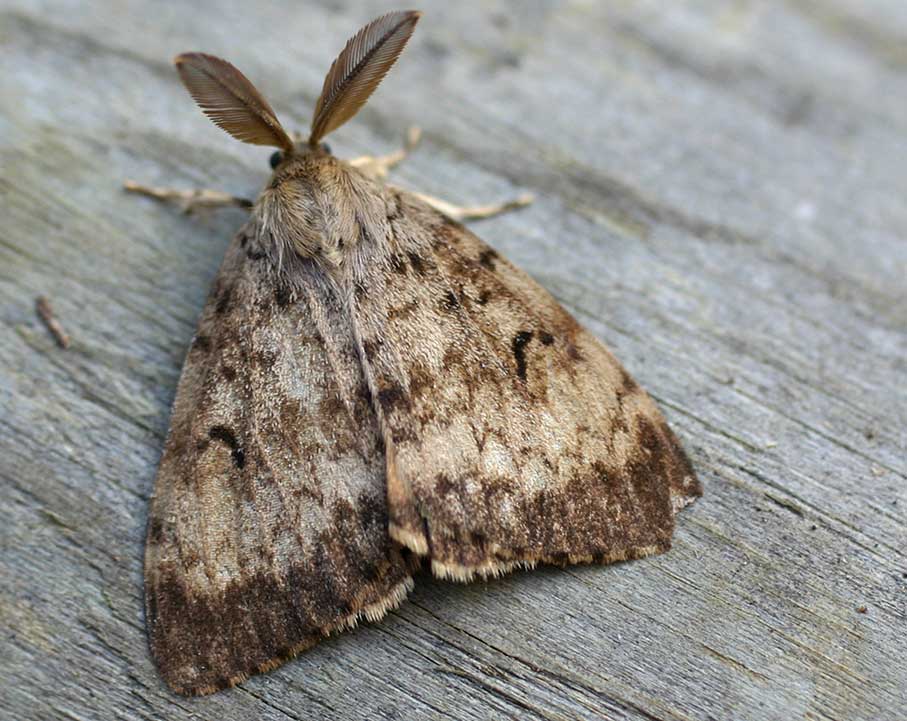
Industry News
News
Canadians asked to watch for invasive pests
August 15, 2023 By Miranda Leybourne, Local Journalism Initiative Reporter
 Adult male spongy moth. Photo courtesy Government of B.C.
Adult male spongy moth. Photo courtesy Government of B.C. This August, the Canadian Food Inspection Agency encourages Canadians to take part in Tree Check Month to protect plants and trees from invasive pests.
Throughout the month, all Canadians are encouraged to inspect their backyards, gardens, local parks and even vehicles for any unwelcome pests.
Plant health is an essential part of Canada’s economic prosperity, the Canadian Food Inspection Agency (CFIA) says, and is directly linked to the health of people, animals and the environment. The introduction and spread of an invasive species could have devastating impacts on human and animal health, and Canada’s forests, agriculture, environment and economy.
“Healthy plants and trees are crucial for our food, agriculture, forestry and environment,” said Dr. Harpreet Kochhar, president of the CFIA. “During Tree Check Month and also every day of the year, I encourage all Canadians to rally in protecting our beautiful country by taking simple steps to ensure the well-being of our plants and trees.”
Many plant pests and diseases affect the health of plants and trees all over Canada. Pests are most often introduced and spread through human activity. Invasive pests in Manitoba include the emerald ash borer, the cottony ash psyllid, and Dutch elm disease.
Tree emerald ash borer is a highly invasive and destructive insect that has killed millions of ash trees in the U.S. and the provinces of Ontario and Quebec, the province of Manitoba says on their “Stop the Spread” website, aimed at raising awareness of invasive pests.
Since the pest is very hard to detect in its early stages, it often goes unnoticed until it’s too late. The province says this is the reason the emerald ash borer is difficult to control and manage. Prevention measures — such as not moving firewood — and early detection are the best defence against the devastating invasive forest insect.
The cottony ash psyllid is an invasive insect that was found in Manitoba in 2017. It infects Manchurian ash trees, black ash trees and hybrids of those two species. Surveys to find additional infestations continue, the province says.
Communities throughout Manitoba historically planted hundreds of thousands of hardy American elm trees, making effective management of Dutch elm disease particularly important to Manitobans. Many communities, in co-operation with the Manitoba government, have been managing the disease for nearly 50 years, preserving mature tree canopies that provide benefits like wind reduction, shade, wildlife habitat and clean air.
Oak wilt was found in Canada for this first time in June. The disease is caused by the fungus Bretziella fagacearum, and red oaks are particularly susceptible to it, resulting in tree death within a single season. Oak wilt is spread naturally through root grafts or beetles carrying fungal spores.
While it does not affect human or animal health, the disease does pose a serious threat to oak trees, and if it spreads it could have a major impact on Canadian forests, the CFIA says.
Another species the organization wants Canadians to watch out for is the Spotted Lanternfly, which has not yet reached Canada but is present in the United States near the Canadian border. The pest can be particularly harmful to vineyards and orchards all across the country.
The CFIA suggests Canadians inspect the trees in their yard and their surroundings, keeping an eye out for unusual or sudden changes in the tree’s health, such as discoloration of leaves, cracks in the bark, the presence of insect holes, tunnels beneath peeled bark and more. Inspections should start at the roots and move upward along the trunk and branches of the tree, looking for noticeable insect populations and signs of feeding activity on the leaves.
Suspected invasive species or plant disease should be reported to the CFIA, as timely reporting allows inspectors to investigate the source and take preventive measures against further spread, and early detection is key.
To prevent the spread of invasive species and pests, Canadians who are travelling are reminded to check for egg masses and insects on vehicles, trailers, boats and more before going on and returning from trips. Firewood should never be moved, as pests and their eggs can be hiding under the bark. The CFIA recommends buying local firewood and burning it locally instead.
The CFIA is giving out free plant health hero activity books where kids can learn about the importance of plant health within their own community and Canada, the numerous threats to plant health like invasive species, and how they can help to protect plant life. The activity books can be found in the plant health section of the CFIA’s website at inspection.canada.ca.
“In the face of both new and recurring invasive species, it is important for all of us to do our part to protect Canada’s trees and plants from the detrimental effects caused by destructive pests,” Dr. Anthony Anyia, chief plant health officer with the CIFA, said. “Now, more than ever, our collective action is essential to safeguarding the well-being of our natural environment.”
Other pests the CFIA wishes people to look out for include the spongy moth, which has a significant impact on forests in eastern Canada and is a major threat to western Canada, the box tree moth, a serious pest of boxwood trees in Ontario, and the Japanese beetle, a major pest in eastern Canada.
Miranda Leybourne is a Local Journalism Initiative reporter for Brandon Sun.
Print this page